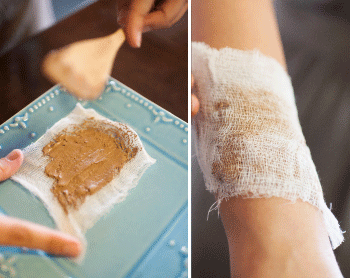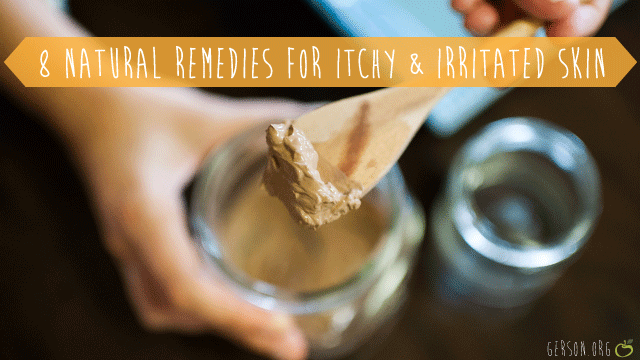Despite your best efforts to ward off bug bites using herbs you can grow in your garden, you might still get bitten, and suffer an itchy welt on your skin. Or, perhaps you might develop an itchy rash, or take a walk in the woods and emerge with poison ivy.
As I write this, I’m sitting at my desk, rubbing a basil leaf on a bug bite on my wrist (I forgot to apply my trusty lemon balm before gardening yesterday). That would probably be considered odd at an average office, but at the Gerson Institute nobody bats an eye when we see someone putting plants to use for healing!
Fortunately, just like there are natural ways to keep bugs off your skin, there are also plants and other natural remedies that can help relieve the itching once you’ve been bitten. Because having itchy, irritated skin is no fun, and being constantly reminded to “stop scratching!” is probably not as helpful as your mom thinks.
However, these remedies don’t only work for bug bites. Many of the methods listed below can be used to ameliorate a variety of skin complaints: rashes, poison ivy, eczema and other itch-inducing skin problems.
Patients on the Gerson Therapy often experience rashes and other odd skin complaints over the course of the therapy, particularly while having healing or detox reactions. This is most often caused by toxins leaving the body through the skin. While it’s unpleasant, it can often be a good sign. It shows that the body is healing.
Without further ado, here are our staff’s favorite anti-itch remedies! These are all totally natural and straight from nature – no lotions, potions or mysterious added ingredients.
Our rule of thumb regarding body products is to never use anything on your skin that you wouldn’t put in your mouth. So, every remedy listed here is made from plants or from plant-based or food-grade substances.
1. Clay
Put a bit of bentonite or Montmorillonite clay on it! Clay is very helpful for itching and a number of other skin issues such as acne. It particularly helps heal venomous stings and bites, like from bees, wasps and spiders. The clay helps draw the venom out of the skin, which will help relieve the pain and let the sting heal more quickly.
Use virgin, untreated clay, such as this one. Green clay (often called montmorillonite or bentonite clay) is the most powerful type.
 How to use it: Mix the clay in a bowl or cup with a bit of filtered water until it has a creamy consistency like peanut butter (like in the picture at the top of the page). Then, just dab the clay paste onto itchy areas, let it dry, then rinse or peel it off.
How to use it: Mix the clay in a bowl or cup with a bit of filtered water until it has a creamy consistency like peanut butter (like in the picture at the top of the page). Then, just dab the clay paste onto itchy areas, let it dry, then rinse or peel it off.
How to do a clay pack: Spread the clay on a piece of clean, porous fabric (i.e., wool, muslin, cotton, flannel). Then place the clay-covered cloth to the irritated area, with the clay directly touching the skin (see the picture on the right). You can use bandaging tape or wrap it in plastic wrap to keep the cloth in place and protect your clothing and furniture. Keep the clay pack on for about 4 hours, or until the clay is hard and dry.
For more detailed instructions and pictures, see: How to Do a Clay Pack
2. Apple Cider Vinegar
 This isn’t the first time we’ve sung the praises of the uber-versatile ACV, and I suspect it won’t be the last. Apple cider vinegar is an effective antiseptic, anti-fungal and anti-bacterial agent that relieves itching, especially itching associated with dry skin (for example: sunburns and dandruff). It’s also popularly used for pets with dry, itchy skin as well, by adding a few capfuls to their bath water.
This isn’t the first time we’ve sung the praises of the uber-versatile ACV, and I suspect it won’t be the last. Apple cider vinegar is an effective antiseptic, anti-fungal and anti-bacterial agent that relieves itching, especially itching associated with dry skin (for example: sunburns and dandruff). It’s also popularly used for pets with dry, itchy skin as well, by adding a few capfuls to their bath water.
How to use it: Just put a few drops of it onto a cotton ball or washcloth and dab it on to the affected area. Use raw, organic, unfiltered apple cider vinegar (Bragg’s is a good brand) with the “mother,” a strand-like sediment floating at the bottom of the bottle that contains raw enzymes and beneficial bacteria.
3. Clay + Apple Cider Vinegar
Combine the anti-itch properties of both of these skin soothers at the same time!
How to use it: Follow the instructions for using clay topically or as a clay pack, just substitute apple cider vinegar instead of water when making your clay. It will fizz up a bit, so just add a tiny amount of vinegar at a time until you reach the desired consistency.
4. Peppermint Leaves
Peppermint is great for bug bites and itching, as it provides a cooling sensation that’ll give you welcome relief.
How to use it: The quickest, easiest way is to crush up the leaves and rub the peppermint directly onto the skin. You could even freeze the crushed peppermint leaves into ice cubes for a cooling double-whammy, as the cold of the ice cubes also helps to numb the affected area and bring down swelling and inflammation. Always use clean, filtered water.
5. Fresh Basil Leaves
Basil leaves contains anti-itch compounds called camphor and thymol. This is my personal go-to trick for bug bites, as it’s so quick and easy. Plus, rubbing the leaf onto the skin satisfies the compulsive urge to scratch.
How to use it: Crush up the leaves and rub directly onto the skin.
6. Aloe Vera
 We love aloe vera for just about every kind of skin irritation. Aloe is probably best-known for its ability to heal sunburns, but it’s extremely versatile as it soothes the skin and relieves swelling and irritation. If you live in Southern California, there’s probably an 85% chance it’s already growing in your yard.
We love aloe vera for just about every kind of skin irritation. Aloe is probably best-known for its ability to heal sunburns, but it’s extremely versatile as it soothes the skin and relieves swelling and irritation. If you live in Southern California, there’s probably an 85% chance it’s already growing in your yard.
How to use it: Break off a leaf from the plant, and cut it open lengthwise from top to bottom with a knife. Scoop out the gooey gel inside, and rub it directly onto irritated skin. If you have extra left over, you can keep it refrigerated in an airtight container for up to a week.
7. Fruit Peels
This is a fun Gerson staff favorite! Rub bug bites with a banana peel or watermelon rind.
This is a great way to re-purpose kitchen scraps that might otherwise be thrown out. But, this method does have a potential drawback: the fruity scent may attract bugs. This may be a better choice for using indoors.
How to use it: Rub peel or rind onto the affected area.
8. Oatmeal
Oatmeal contains compounds called avenanthramides that reduce inflammation. This is a popular trick that’s been around for ages; I can remember my mom making me take oatmeal baths when I had chicken pox as a little kid. It’s also commonly used for poison ivy and eczema. You can add oatmeal to your bath, or make a poultice.
How to use it: To make an oatmeal poultice, add a bit of water to a cup or bowl of plain, organic, uncooked oatmeal (ground or steel-cut work best for this), then let it sit for a few minutes until it reaches a paste-like consistency. Apply the paste to the itchy area as needed.
 Educational articles like this are made possible with the help of your donations. Help us continue the legacy of Dr. Max Gerson, his daughter Charlotte Gerson, and the thousands who rely on the Gerson Institute for vital education and training.
Educational articles like this are made possible with the help of your donations. Help us continue the legacy of Dr. Max Gerson, his daughter Charlotte Gerson, and the thousands who rely on the Gerson Institute for vital education and training.





Comments14
Yes rub any wet iron object ( like a key ) on a stone and lift the resultant solution by fingers and apply it on the affected part .
For itchy, burning bug bites, I use
baking soda and add a little bit purified water. Just add enough
water to make a thicker paste of it. Put as a poultice with that
baking soda paste. It takes away all the burning and itching very
quickly.
For bee stings and bug bites I pick some blue flag, crumble the leaves to release the juice and apply. I’ve never had to do anything additional once I arrive home as long as I manage to find the blue flag fairly quickly. It’s such a common roadside weed, it’s never been difficult to find when needed, at least not in the Pacific Northwest.
Baking Soda is not recommended for Gerson Therapy because is a form of sodium.
Coconut oil works best for severely dry skin!
hi can i apply the coconut oil in my face the affected part is my pores it not like its acne because its too itchy and dry .. i tried to put some petroleum so that the dryness will gone and i also use some moisturizing cream .. hope you can suggest more herbal medicine to help me deal with my allergy . great thanks
Yes. I have been using coconut oil allot lately. My skin had never been happier.
me and my husband and kids been itching non stop we can feel them moving and bitting but we cant see them or feel them on our skin. i hate living like this help
Mosquitoes don’t bother me and I think it’s because I use Lavender soap, shampoo and other products with the essential oil of Lavender. Ban Roll on deodorant is the best thing I have found for bee stings. It has something in it that breaks down the protein and stops the pain. I keep some handy just for that.
Three awesome things that help with itching, and one of them is probably in your back yard RIGHT NOW:
1. Strawberry heads — the part you cut off before you eat the strawberry (the fruit works, too, but why use it when you can use the heads? I save them and keep them in the refrigerator for this). Rub this directly on skin and let dry. It’ll be gooey until it dries, but after that your skin will be really soft and smell like strawberries.
2. Jewelweed [impatiens capensis] — found wild and easy to identify because of its jewel-bright, yellow or orange flowers in midsummer. It’s a great (and instant) cure for poison ivy, but works on all itches.
3. Wild broadleaved plantain [plantago major] — It’s a weed! Found everywhere. Perfect for mosquito bites. The thin-leaved variety works, too, but the wide-leaved kind has more juice. This plant is also edible.
Aloe Vera IS THE BEST FOR ITCHING SKIN, BITES, AND SUN BURN! You must have an Aloe Vera plant in your House! You can buy one at WalMart for of $4.99! What a great investment. I brought a plant back from Florida over 15 years ago, and we still have it and use it every year!
I love Aloe Vera it works great! 3 years ago, my neighbor gave me a big pot of it to grow. Now I also share it with my children and neighborhood.
I
I use organic coconut oil as my hair conditioner. I also use on my face & body it makes you look young & fresh. My husband has a rash from his polymyalgia Rhematica Iput the coconut oil on & it instantly stops the itching.
My 13 year old granddaughter showed me the best treatment for mosquito bites ever: firmly press the edge of a credit card, or like, into the edge of the swelling, pressing down and slightly under it; hold for a few seconds, and release. Wait . . . bite’s gone.
Comments are closed.